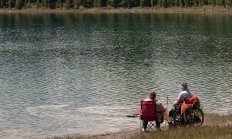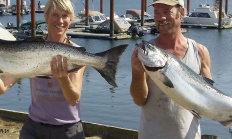
Search myodfw.com
The modern compound bow is the most popular choice for turkey hunting, but traditional recurve and longbows also have their fans. Hunting with crossbows is illegal in Oregon. If you already have a bow you use for deer or elk hunting, it will work fine for turkey Many turkey hunters, though, like to reduce the draw weight of their deer/elk hunting bow to 45 pounds or less for turkey. Unlike deer and elk hunting, where you’re usually standing or kneeling when you take a shot, you’re likely to be sitting when shooting a turkey. In this case, a lighter draw



Oregon requires all hunters under the age of 18 to complete a hunter safety education course before hunting in the state. Upon completing the course (and a Field Day for youth), participants will receive a Hunter Safety certification number and card. Adults are also encouraged to take the online course, as it may be required for out of state hunts. Note: Youth under the age of 9 may struggle with the course material and may not have the physical strength needed to safely handle a firearm during a Field Day, particularly during muzzle control, loading, and unloading drills.
Statewide


Wenaha Wildlife Area, near Troy, OR 45°56'46.3"N 117°26'12.7"W

These calls have nothing to do with calling in turkeys, but everything to do with finding toms. Owl, crow, peacock, woodpecker and hawk sounds all can elicit a reactionary gobble from a tom – sometimes called a “shock gobble.” These calls are usually used when birds are on the roost early in the morning or late in the evening. Using a hen call to locate a tom can put the tom on the move before you’re ready to set up. If a tom comes in too quickly, it can mean a blown opportunity. Locator calls encourage toms to gobble without

Prineville Reservoir Wildlife Area came under the shared management of the Oregon Department of Fish and Wildlife & United States Bureau of Reclamation in 1962. It is managed for the protection and enhancement of wildlife habitat, big game winter range, improving riparian wetlands, and to promote wildlife stewardship. Goals of the PRWA include creating recreational opportunities for viewing and enjoying wildlife, including mule deer, bald eagles, and a variety of waterfowl. Boating, hiking, and camping are a few popular activities permitted in the wildlife management area. Hunting and fishing opportunities are also available within Prineville Reservoir Wildlife Area, as regulated


Establishment of the Bridge Creek Wildlife Area initially started in 1961 when a parcel of land was purchased from the Frank Hilbert estate. After the initial purchase, several private holdings were acquired to consolidate the land under department ownership. The last parcel was purchased from the Colvin Cattle Company in 1975. The primary purpose of the wildlife area is to maintain and protect a key historic winter range for Rocky Mountain elk ( Cervus elaphus nelsoni).
Coquille Valley Wildlife Area was initially established in 2013 with two equally important primary objectives; (1) To protect, enhance, and restore fish and wildlife habitats located on the WA, and (2) to provide a wide variety of wildlife-oriented recreational and educational opportunities to the public.
WILLAMETTE WILDLIFE VIEWING December 4, 2025 Corvallis area EE Wilson Wildlife Area There are lots of deer, shorebirds and waterfowl to see on the wildlife area – look for goose, mallard, hooded merganser and wood duck broods. Wildlife viewing remains good for waterfowl and shorebirds. Note: Dogs are required to be on a leash inside the wildlife area boundary. Rifles and pistols are prohibited year-round. Find directions to EE Wilson Wildlife Area. A parking permit is required to park at EE Wilson Wildlife Area. Find out how to buy a parking permit. Eugene area Fern Ridge Wildlife Area Observant visitors
Crabbing and Clamming Dec 4, 2025 Always check for closures at the ODA Shellfish Safety page before harvesting shellfish, which includes clams, crabs and mussels. Announcements Chinese mitten crab found in Willamette River A second confirmed Chinese mitten crab, a prohibited species in Oregon, was found and reported to ODFW on November 17 in the Willamette River near Sellwood Bridge. The first mitten crab was caught on April 22 in the Lower Columbia River. Mitten crabs caused significant infrastructure and ecological damage in and around San Francisco Bay when the population was at its height in the late 1990s and


There are fundamental differences between turkey hunting with a bow and a shotgun, including effective range, shot placement and set up. Effective shooting distance Your effective shooting distance (how far you can be from a turkey and likely kill it with a single shot) will vary with the level of your shooting skills and the type of equipment you’re using. A good rule of thumb for shotgun shooters is 40 yards. Anything further than that and there’s a good chance you might not hit the head and neck with enough pellets to kill the bird. Any closer than 20 yards


The development of the WWA began in 1953 with the acquisition of five parcels of land consisting of 4,400 acres. The Department continued to purchase additional lands, acquiring 1,670 acres in 1954 and another 760 acres in 1955. From 1961 to the present the department has purchased or received another 4,219 acres. The wildlife area currently consists of 12,419 acres owned by the department. In addition, the department, through agreements with the Bureau of Land Management (BLM), manage 1,329 acres within or adjacent to the wildlife area. The WWA was established in response to continuing complaints from landowners concerned with
